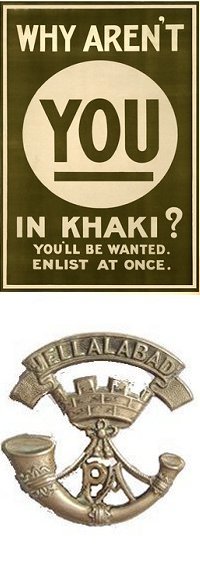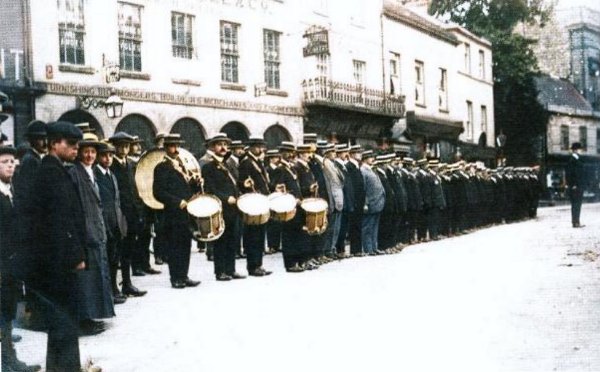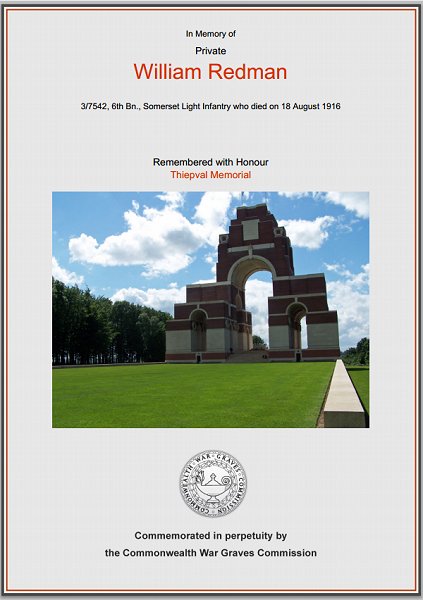yeovil at War
William Redman
Killed in action in the Battle of Delville Wood
William Redman was born in Yeovil in 1887, the son and eldest child of tailor John E Redman (b 1852) and his wife Margaret (b 1853). In 1901 John and Margaret were living at 20 Queen Street with their children; William, Percy (b 1892), Mabel (b 1893), Ethel (b 1894), Elsie (b 1895) and John (b 1896). 14-year-old William listed his occupation as 'Painter (House)'.By the time of the 1911 census William and his younger brother Percy were living as boarders at 10 Rustywell. 25-year-old William gave his occupation as painter and Percy, aged 20, gave his as a lamplighter.
In the summer of 1911 William married Alice K Banfield at Yeovil, and they set up home in Eastland Road. Around this time William was employed as a paper hanger by Barretts of Middle Street. However William had also probably served with the Volunteer Battalion of the Somerset Light Infantry, or at least had some form of military experience, and was consequently a National Reservist.
 Since
William was a
member of the
Yeovil Company
of the National
Reserve, he
enlisted at
Yeovil on the
outbreak of war,
joining the 6th
Battalion,
Somerset Light
Infantry
(Service No
3/7542). In fact
he may, indeed,
be one of the
men in the first
photograph below
of the Yeovil
Company of the
National Reserve
in the
Borough,
taken the day
war was
declared.
Since
William was a
member of the
Yeovil Company
of the National
Reserve, he
enlisted at
Yeovil on the
outbreak of war,
joining the 6th
Battalion,
Somerset Light
Infantry
(Service No
3/7542). In fact
he may, indeed,
be one of the
men in the first
photograph below
of the Yeovil
Company of the
National Reserve
in the
Borough,
taken the day
war was
declared.
The 6th Battalion had been formed at Taunton in August 1914, becoming part of the 43rd Brigade, 14th Division at Aldershot later that year. On 21 May 1915 the 6th Battalion landed at Boulogne, France.
The Battalion spent the first week or so marching across France towards Belgium where they spent about a week supplying working parties for the digging of trenches for a secondary positions southwest of Ypres. By Sunday 13 June the Battalion settled down to trench life and the Regimental History of the Somerset Light Infantry recalled for that day "The trench life was very quiet. A little shelling early in the morning and desultory rifle fire during the day.... The trenches taken over were situated in a dangerous position. They had been captured from the enemy only a few days previously I had occupied the most easterly point of the British position in Belgium, in front of Hooge. The line generally was in a very bad state and under incessant shellfire from the North, East and South. From 30 June to 18 July the 6th Somersets remained in billets, supplying large working parties day and night."
On 26 July 1915, while at Hooge, the Battalion was subjected to a new weapon of war - the flamethrower. This event is described in the Regimental History of the Somerset Light Infantry "Very early in the morning the front-line trenches of the Brigade were suddenly flooded by liquid fire, which belched from jets in the German lines opposite. This new device momentarily caused surprise and confusion, and the victims of this dastardly attack fell back from the front-line trenches which were then occupied by the enemy."
During 1916 the 6th Battalion fought in the trenches of the Western Front and in this year were involved in the action at Delville Wood in the Battles of the Somme. Delville Wood is to the north east of the town of Longueval in the département of the Somme in northern France.
After the two weeks of carnage from the commencement of the Somme Offensive, it became clear that a breakthrough of either the Allied or German line was most unlikely and the offensive had evolved to the capture of small prominent towns, woods or features which offered either side tactical advantages from which to direct artillery fire or to launch further attacks.
Delville Wood was one such feature, making it important to German and Allied forces. As part of a large offensive starting on 14 July, General Douglas Haig, Commander of the British Expeditionary Force, intended to secure the British right flank, while the centre advanced to capture the higher lying areas of High Wood in the centre of his line. Delville Wood was a battle to secure this right flank. The battle achieved this objective and is considered a tactical Allied victory. However, it was one of the bloodiest confrontations of the Somme, with both sides incurring large casualties.
According to the Regimental History of the Somerset Light Infantry, after the first phase of the Battle of Delville Wood, the 6th Somersets had spent several days in billets in Fricourt. During August the battalion was involved in the taking of Hop Alley and Beer Trench adjoining Delville Wood. After much heavy fighting the whole of Hop Alley passed into the hands of the Somerset men. Following the fighting, according to the Regimental History, "They dug a new CT (communication trench) under heavy fire and did it quickly and well. Also carried wire, stakes, etc, to the front line. Sent back 82 prisoners under escort. Carried bombs and sandbags. Put up artillery boards. Sent 20 men to fill gap on our left. Sent 20 men to make and hold a strong point in gap between right companies. Sent 30 men to support C company in Hop Alley. And then, when night had fallen, the remainder of this gallant company carried bombs, SAA, water, etc. to the front line."
The Regimental History continues "A little later (at 5pm) officers of the 9th Rifle Brigade came to look round the trenches of the 6th Somersets and made arrangements for taking them over. Hostile shelling, however, prevented the relief taking place until almost midnight, but this was all to the advantage of the Somerset men, who had no casualties in coming out of the line. The relief was completed at 4:15am, the battalion being billeted in Fricourt. "The men," stated the Battalion Diary, "on arrival in rest billets, were absolutely beat; the authorities had wisely kept them until the last possible moment and then taken them out." Thus ended another phase of the Battle of Delville Wood, a phase which cost the regiment five officers killed and seven wounded, with 48 other ranks killed and 220 wounded and missing. William was among those killed in action and died on 18 August 1916. He was 29 years old.
The Western Gazette reported in its 29 September 1916 edition "Mrs W Redman, who for some time resided in Eastland Road, received a report from the War Office on Sept. 4th, stating that her husband, Private Redman of the Somerset LI, was missing after the engagement on August 18th last. Private Redman, who was, previous to the war, employed by Mr Barrett, of Middle Street, as a paper hanger, was a National Reservist, and had been in the Army previously. He had seen 15 months active service."
On 6 July 1917 the Western Gazette reported "Mrs Redman has received notification from the Record Office that no further news of her husband, Priv. W Redman, of the Somerset Light Infantry who has been missing since August 18th 1916, has come to hand, and the Army Council regretfully conclude that he was killed on the date mentioned."
William Redman is commemorated on Pier and Face 2A of the Thiepval Memorial, and his name is recorded on the War Memorial in the Borough.
gallery

On Bank Holiday Monday, 4 August 1914, Yeovil men of 'E' (Yeovil) Company, 1st (West) Somerset Battalion of the National Reservists, known colloquially as the 'Straw Hat Brigade', line up in the Borough before marching to the Town Railway Station and travelling to Taunton. War was declared at midnight. William is almost certainly in this photograph.

The Commonwealth War Graves Commission certificate in memory of William Redman.